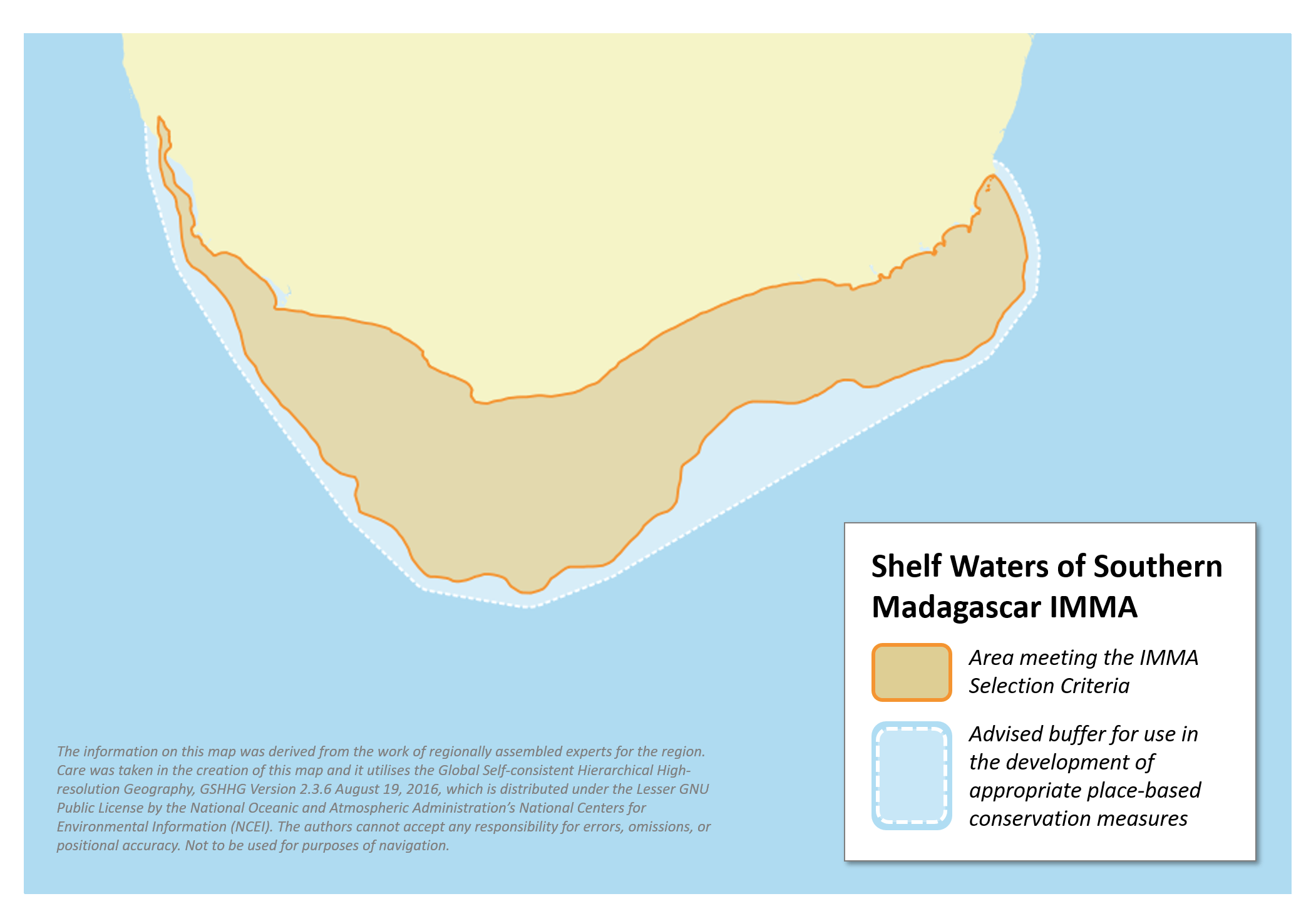Shelf Waters of Southern Madagascar IMMA
Size in Square Kilometres
18 575 km2
Qualifying Species and Criteria
Humpback whale – Megaptera novaeangliae
Criterion B (2); C (1, 3)
Download fact sheet
Summary
The area encompasses the wide portion of the continental shelf waters and slope off Southern Madagascar. The western edge approximates the location of the town of Androka in southwest Madagascar and extends eastwards to Tôlanaro / Fort Dauphin, and extends seaward to encompass the upper half of the continental slope. This area contains important habitat for aggregations of breeding humpback whales and also represents an important portion of the migration route for this species in the region. Kernel density models demonstrate a breeding ‘hotspot’ in the waters off southern Madagascar for humpback whales satellite tagged off Reunion Island for both males and females with calf, although relatively more so for males, as well as for whales satellite tagged in the southwest of Madagascar off Toliara / Anakao. These ‘hotspots’ are observed to span the waters from the coastline out to the continental shelf edge on the eastern portion of the shelf and were used to delineate the eastern boundary of the area.
Description of Qualifying Criteria
Criterion B: Distribution and Abundance
Sub-criterion B2: Aggregations
The area represents an important aggregation area for breeding humpback whales. Aggregations were determined from kernel density models of satellite telemetry data to exist off Southern Madagascar, including south of Fort Dauphin extending seaward to the Madagascar Plateau (Dulau et al. 2017). The area is also used by whales tagged in southwest Madagascar (Anakao) and in the central east of Madagascar (Sainte Marie) (Cerchio et al., 2016).
Criterion C: Key Life Cycle Activities
Sub-criterion C1: Reproductive Areas
Satellite tracking data revealed new inferences on habitat utilization in Madagascar, with the central eastern and southern coast identified as areas with high concentrations of localized movements, and therefore main breeding habitats of humpback whales within the area (Dulau et al., 2017; Cerchio et al., 2016). When reaching Southern Madagascar, several tagged individuals switched to localised movement behaviour and remained in the area for up to 15 days (Dulau et al., 2017). Kernel density models derived from satellite telemetry data highlight breeding ‘hotspots’ on the eastern portion of the shelf, off Fort Dauphin (Figure 1b, Dulau et al. 2017). The similarly wide continental shelf area to the west also represents important breeding habitat for the species (Cerchio et al., 2016; Trudelle et al. 2016).
Sub-criterion C3: Migration Routes
There are multiple sources of evidence of extensive humpback whale movements and genetic connectivity between the area of southern Madagascar, other areas surrounding Madagascar, as well as areas off east Africa and the Mascarenes (Rosenbaum et al. 2009; Ersts et al. 2011; Fossette et al. 2014; Cerchio et al. 2016; Trudelle et al. 2016; Dulau et al. 2017; Kershaw et al. 2017). More broadly, the area falls within the migratory stream of Breeding Stock C whales as they commute annually between productive feeding areas in the Southern Ocean and warmer wintering grounds off East Africa, the Comoros Archipelago, Madagascar, and the Mascarenes.
Supporting Information
Cerchio, S., Trudelle, L., Zerbini A.N., Charrassin, J.B., Geyer, Y., Mayer, F.X. et al. 2016. ‘Satellite telemetry of humpback whales off Madagascar reveals insights on breeding behavior and long-range movements within the southwest Indian Ocean’. Marine Ecology Progress Series, 562: 193–209.
Dulau, V., Pinet, P., Geyer, Y., Fayan, J., Mongin, P., Cottarel, G. Zerbini, A.N., and Cerchio, S. 2017. ‘Continuous movement behavior of humpback whales during the breeding season in the southwest Indian Ocean: On the road again!’ Movement Ecology 5: 11 [online]. Available at: DOI 10.1186/s40462-017-0101-5
Ersts, P.J., Pomilla, C., Kiszka, J., Cerchio, S., Rosenbaum, H.C., Vély, M. et al. 2011. ‘Observations of individual humpback whales utilizing multiple migratory destinations in the south-western Indian Ocean’. African Journal of Marine Science, 33: 333–338.
Fossette, S, Heide-Jørgensen, M.P., Jensen, M.V., Kiszka, J., Bérubé, M., Bertrand, N., and Vély, M. 2014. ‘Humpback whale (Megaptera novaeangliae) post-breeding dispersal and southward migration in the western Indian Ocean’. Journal of Experimental Marine Biology and Ecology, 450: 6–14.
Kershaw, F., Carvalho, I., Loo, J., Pomilla, C., Best, P.B., Findlay, K.P., et al. 2017. ‘Multiple processes drive genetic structure of humpback whale (Megaptera novaeangliae) populations across spatial scales’. Molecular ecology, 26: 977–94.
Rosenbaum, H.C., Pomilla, C., Mendez, M., Leslie, M.S., Best, P.B., Findlay, K.P., Minton, G., Ersts, P.J., Collins, T., Engel, M.H. and Bonatto, S.L. 2009. ‘Population structure of humpback whales from their breeding grounds in the South Atlantic and Indian Oceans’. PLoS One, 4(10) [online]. Available at doi:10.1371/journal.pone.0007318 (Accessed: 1 February 2010)
Trudelle, L., Cerchio, S., Zerbini, A.N., Geyer, Y., Mayer, F.X., Jung, J.L., Hervé, M.R., Pous, S., Sallée, J.B., Rosenbaum, H.C. and Adam, O., 2016. Influence of environmental parameters on movements and habitat utilization of humpback whales (Megaptera novaeangliae) in the Madagascar breeding ground. Royal Society open science, 3(12) [online]. Available at https://dx.doi.org/10.6084/m9.figshare.c.3593711 (Accessed: 3 January 2017)


